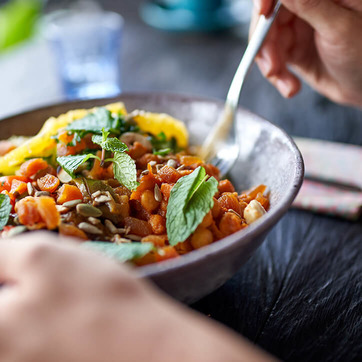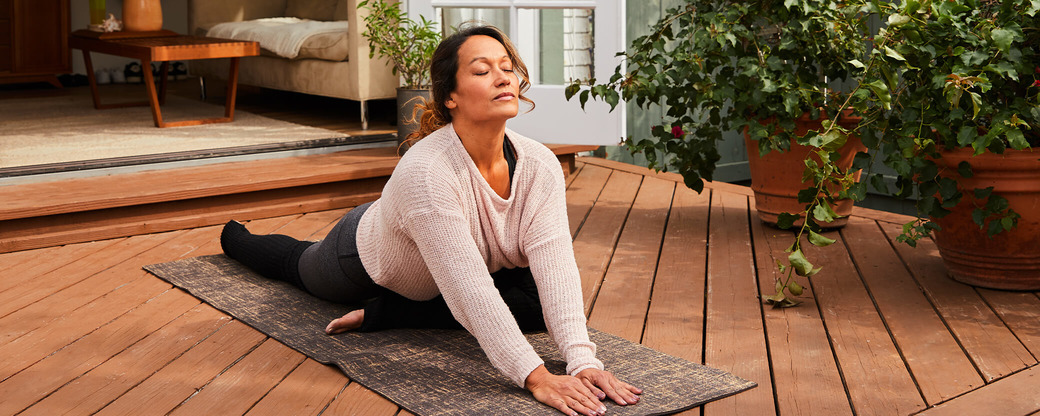Synovial fluid is formed within the articular capsule, diffusing as a viscous lubricant between the articular head and articular cavity. Synovial fluid regenerates continuously and transports nutrients to the cartilage. Ligaments provide the articular capsule with the required stability. The complete locomotor system also includes the muscles that connect adjacent bones via tendons.
Functions of articular cartilage
Articular cartilage covers the articular surfaces of bones and has an extremely smooth and resistant surface. The cartilage itself possesses a stratified structure and is a porous, liquid permeable medium.
Healthy articular cartilage is indispensable for good joint function. It has the important mechanical function of enabling free joint mobility, absorbing influencing forces and reducing friction on the joint surfaces.
Though it is only a few millimetres thick, it has a surprising capacity for mechanical stress absorption and weight distribution. Furthermore, it covers the joints with a smooth surface so that the bones can glide against each other without too much friction.
Articular capsule
The articular capsule consists of two layers. The inner layer consists of loose connective tissue and the outer layer of taut collagen connective tissue. The articular capsule is enveloped by a thin, white, glossy layer which can often be less than one millimetre thick. The function of the articular capsule includes the production of synovial fluid. Its principal function is the nutritive support of the articular cartilage. In addition, it serves to “lubricate“ the joint. The articular capsule with its numerous receptors supplies the central nervous system with information on the position and movement of the joint. Ligaments and muscles (and/or capsule tensors) ensure the stability of the articular capsule.
Synovial fluid, als called "synovia"
“Synovia” is normally contained in the joint. It is highly viscous and is located as a delicate film between the joint surfaces. Very little synovia is normally found in a healthy joint: in a knee joint, for instance, approx. 0.5 - 2 ml.
Causes of joint attrition
The joint is so perfectly constructed that attrition does not occur very quickly. The so-called wear of the joint (“arthrosis”) often affects the elderly but it is not an inevitable manifestation of old age. We often speak of joint attrition, but in the majority of cases the cause of this is cartilage weakness.
This weakness often occurs as a result of incorrect diet and insufficient nutrient supply to the cartilage; mechanical strain also plays a role.
The extremely smooth cartilage surface can become rough and cracked. This is often the underlying cause of cartilage degradation. The nutrient supply to the cartilage cells is then impaired and the cells become disconnected in the gelatinous cartilage substance. Consequently they have no immediate contact to their adjacent cells, and therefore do not receive any information when minor damage has developed in the cartilage. In contrast to other tissues, minor defects cannot be remedied immediately through the interaction of several cells.
Cartilage damage
When the cartilage has been damaged, for instance due to overstrain or disease, it can no longer fulfil its functions.
The free mobility of the joint is impaired, influencing forces (e.g., hard jolts) can no longer be cushioned so well and friction on the joint surfaces increases.
Small cartilage particles can splinter, e.g., through a strong jolt, and enter the joint cavity.
The irritation of the inner skin due to splinters can cause inflammation. The enzymes being formed at this point have to dissolve the intruding cartilage particles. The simultaneous contact with healthy cartilage can also have a detrimental effect on this, thereby intensifying the inflammatory reaction, and subsequently the joint function may be impaired further.
Various factors can have an impact on the development of cartilage injuries:
- Overstrain of joints due to excess weight, or overstrain caused by work or sports, bad posture, as well as congenital or acquired defective positions, e.g., of the hips.
- A lack of control of joint load, e.g., in the case of spastic paralysis, can also produce overstrain of joints.
- Diseases such as arthritis or gout can damage the cartilage.
- Metabolic disorders can lead to a deficiency in production of glucosamine glycans that are essential to preservation of joint health and regeneration.
- Surgical interventions and joint lesions also raise the risk of cartilage damage.
- A certain disposition to joint attrition may also have hereditary causes.
The nutrient glucosamine – What is glucosamine?
Glucosamine is a nutrient the body needs to build structural components, and it has a role in cartilage metabolism and thus also in articular cartilage metabolism.
It concerns special protein structures called amino sugars. Glucosamine is needed for the formation of these so-called glucosamine glycans. As a component of articular cartilage they have an essential function in the maintenance of health and regeneration of joints. The human body produces a certain amount of glucosamine. The ability to produce sufficient glucosamine may slow down with advancing age. The daily diet also contains glucosamine to a small extent. There are some indications, however, that many people may have a higher glucosamine requirement for maintaining and building up the body’s glucosamine store.
The nutrient glucosamine – What is glucosamine?
Glucosamine is a nutrient the body needs to build structural components, and it has a role in cartilage metabolism and thus also in articular cartilage metabolism.
It concerns special protein structures called amino sugars. Glucosamine is needed for the formation of these so-called glucosamine glycans. As a component of articular cartilage they have an essential function in the maintenance of health and regeneration of joints. The human body produces a certain amount of glucosamine. The ability to produce sufficient glucosamine may slow down with advancing age. The daily diet also contains glucosamine to a small extent. There are some indications, however, that many people may have a higher glucosamine requirement for maintaining and building up the body’s glucosamine store.

What are the tasks of glucosamine?
An adequate amount of glucosamine in the body is essential to the production of nutrients stimulating the formation of synovial fluid – the fluid that lubricates the cartilage and keeps the joints healthy. Glucosamine has a special effect on the synovia, markedly thickening and enhancing its elasticity.
It supplies the cartilage with nutrients and stimulates the regeneration of damaged cartilage tissue.
The synovia can again exert its buffering function so that there is no further friction between the bone ends.
Without enough glucosamine, the cartilage in weight-bearing joints cannot fulfil its tasks. The cartilage then hardens and forms bone spurs, deformed joints and limited joint movement.
Glucosamine is considered a nutrient because it is present in the body and can be found in our daily diet.

Doppelherz joint capsules with glucosamine – essential vitamins for healthy cells
Glucosamine is appropriately supported by combining it with vitamin C and E, as well as the trace elements zinc and selenium. The body needs vitamin C, among other things, for the metabolism of cartilage and for building bone matrix, since it is involved in various metabolic processes that maintain bones and supporting tissues. Together with vitamin E and trace elements zinc and selenium, vitamin C furthermore promotes the health of cells – including cartilage cells – and gives a boost to the body’s defence mechanisms.
How can you take precautions? – Tips to help you eat the right food and protect the joints
Health nutrition
To keep joints healthy, nutrition and lifestyle are of crucial importance. So smoking should be avoided because it reduces oxygen supply in general, and also to the cartilage and joint capsule. A balanced diet including wholegrain products and plenty of fresh fruit and vegetables has positive effects.
Vitamins E and C, as well as selenium, constitute a good supplement to fight free radicals. Calcium and vitamin D are crucial for strengthening bones.
Furthermore, special supplements containing glucosamine can contribute to keeping joints healthy.
Excess weight
Joint complaints and attrition occur more often in overweight than in normal-weight people. When the bodyweight is too high, the joints are worn out more quickly, due to the extra strain, than in normal-weight people. So being overweight promotes the development of arthrosis, and puts further strain on joints in cases of pre-existing joint trouble.
Here, weight reduction is recommended first and foremost. Losing weight and/or maintaining a normal weight is an excellent joint protection. Energy requirement decreases noticeably with advancing age, and therefore weight reduction and/or maintaining a normal weight is possible only by eating less and/or moving more.
Sports may help in reducing body weight. Sports practised in the wrong way, however, represents a risk factor for joint complaints. If you are not trained and would like to become fit, you should seek medical advice.
Taking care of joints
It is important to protect the joints from heavy and one-sided strain. This applies to joints that are damaged already, but it is also a preventive measure. Any pain should be avoided.
In daily routine there are many opportunities to contribute to the protection of joints:
- Don’t sit still for hours / don’t remain in a rigid posture; instead change the position more often, get up in between, walk around, stretch …
- Pay attention to correct working heights at work and at home.
- Avoid heavy loads, e.g. distribute shopping bags equally to both arms.
- When lifting objects bend your knees and lift the load as closely to the body as possible.
- Use a high-quality, medium hard mattress that supports the natural shape of the spine.
- Look out for good shoes: comfortable foot bed and soft, cushioning soles.
- Conclusion: avoid at all costs anything that causes strain or even pain! However: joints which are especially delicate also need movement!
Recommended types of sports and movement
Movement improves lubrication of joints
What happens in the joint during sports? The positive effect is primarily attributed to the fact that moderate movement enhances the formation of synovia.
This synovia is particularly important for nourishing the cartilage and smooth gliding of the joint surfaces on one another. Furthermore, the muscles and ligaments guiding the joint are strengthened and thus the joint is stabilised. Strong muscles and ligaments support the joint and prevent unnecessary knocks and micro-injuries to the cartilage.
Therefore, joints need physical activity to remain mobile as long as possible and to be able to better feed the joint cartilage.
In the case of joint trouble, a thorough examination should be done first, followed if necessary by a sports consultation.
What kind of sport is best for joint trouble?
The kinds of sports that mobilise joints in a gentle manner and without great strain should be given preference. All kinds of movements that can be done smoothly and without great effort are gentle to the joints.
In short: a lot of movement – without strain.
Hard floors, abrupt changes in the sequence of movements, as well as the kinds of sports involving violent starting and braking actions should be avoided. Swimming and Aqua Jogging are especially suitable kinds of sports. Other kinds of sports that are gentle on the joints are also cycling, cross-country skiing or gentle gymnastics. Also trend sports and/or Nordic Walking (fast walking with hiking sticks), exotic sports like Tai Chi (Chinese shadow boxing) or Yoga increase the mobility of joints and strengthen the muscles.
Aqua jogging and swimming
The joints do not have to carry the bodyweight in water, because the body is “floating”. This is a great relief for the joints. In Aqua Jogging, muscle-strengthening exercises that do not strain joints and circulation are done in the water. As for swimming styles, crawl and backstroke are preferable; however breaststroke has an unfavourable effect on the neck and trunk muscles, because of the hollow back.
Nordic Walking
Walking is a gentle but extremely effective, healthy kind of sport for training the whole body.
This sport can be done by everybody; as a starting point for untrained and overweight people and as a new kind of sport for the elderly; but also performance-oriented sportsmen/women can increasingly be found among the walkers. To start with walking hardly anything is needed except for good walking or jogging shoes.
Nordic Walking (fast walking with hiking poles) has established itself successfully, because the gentle walk leads in a pleasant way to greater mobility, strength and endurance. It is particularly suitable for those who have problems with their joints when walking. Because by using the poles correctly, the bodyweight is actually distributed from two to four legs, and this distribution enormously relieves the joints.
With „Nordic-Walking“ you can utilize 90% of your muscles, i.e. about 600, besides which you can burn up to 400 calories per hour. Hence, it is also an ideal way to reduce any overweight.
Sports despite pain?
The bone-protecting cartilage can be protected from “starvation” and degradation only with the aid of exercises. Therefore, moving the joints is very important. To prevent pain, however, the joint should be moved without strain if possible; this means round and gliding movements without much effort. The joint can also be prepared for the exercise, e.g., by applying hot compresses.
Avoid movement when …
… the joint is intensely reddened or swollen or the pain is too severe. In these cases, the joint should rest until the inflammation is relieved. Cold compresses or appropriate medicines can relieve the inflammation.
Sudden joint pain of unknown origin should be discussed in every case with a doctor.
